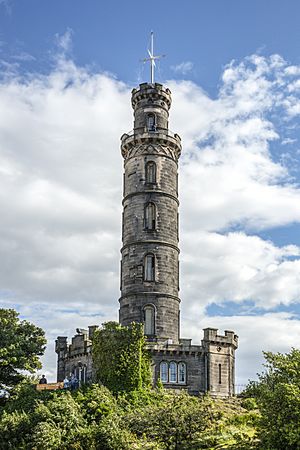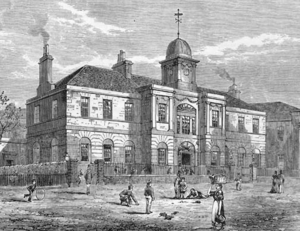Robert Burn (architect) facts for kids
Robert Burn (1752–1815) was a talented Scottish architect. He was also the father of another famous architect, William Burn.
Contents
Who Was Robert Burn?
Robert Burn was born in 1752. His birthplace was Jessfield House, located between Newhaven and Leith in northern Edinburgh, Scotland. He was the oldest son of Robert Burn and Mary Patterson.
Robert Burn learned a special skill: he trained as a monumental stonemason. This meant he was skilled at working with stone to create large structures and monuments.
Early Career and Recognition
From 1772 to 1775, Robert worked for James Weir. His job was to repair and rebuild St Cuthbert's Church, Edinburgh. This was an important early project.
In 1782, he became a "burgess" of Edinburgh. This was a special title that gave him certain rights and responsibilities in the town. Later, in 1796, he joined the Dean of Guild Council. This council helped manage building projects and trade in the city.
Teaching and Business
From 1805 to 1815, Robert Burn ran a drawing academy. This school was located at Picardy Place in Edinburgh. It later became known as the Trustees Academy. The school moved to the Royal Institution in 1826.
By 1814, his business was called Robert Burn and Company. They were builders and marble-cutters. They had workshops on Leith Walk. Around this time, he likely lived with his son, Thomas Burn, at 24 Greenside Street.
Robert Burn's Final Resting Place
Robert Burn passed away on June 5, 1815. He was buried in a grand Gothic-style tomb. This tomb is located in the Old Calton Burial Ground in Edinburgh city centre. His grave is one of the largest in the cemetery. It is only smaller than the nearby tomb of the famous philosopher David Hume.
Robert Burn's Family Life
Around 1785, Robert Burn married Janet Laing (1765-1833). They had a very large family, with 16 children!
What Did Robert Burn Build?
Robert Burn designed and built many important structures. Here are some of his notable works:
- Edinburgh Public Dispensary (1776): This was a place where people could get medical care.
- Gravestone for Robert Fergusson (1779): He designed the tombstone for the poet Robert Fergusson. This was asked for by another famous poet, Robert Burns.
- Cairness House (1782): A large country house near Fraserburgh.
- Planning of Nicolson Street (1785): He helped plan the layout of Nicolson Street in south Edinburgh.
- Hermitage of Braid (1785): A beautiful house and estate.
- Buildings on Leith Street (1790): He built a row of houses at 141 to 171 Leith Street in Greenside, Edinburgh. These buildings were taken down in 1969.
- Netherurd House (1791): A large mansion in the Scottish Borders. It was used as a centre for Girl Guides until 2020.
- Teviot Bank House (1791): A house located in Hawick.
- Orbiston House (1795): A house in Bellshill that was later destroyed by fire.
- Remodeling of St Giles Cathedral (1796): He likely added some Gothic-style spires to the outside of this famous cathedral.
- Cairnfield House (1799): A house in Buckie, which has now been divided into apartments.
- James Gillespie's School (1800): A school building.
- Lakeside House at Gordon Castle (1800): A house by a lake on the Gordon Castle estate.
- Claremont Park Plan (1801): He created the building plan for Claremont Park on Leith Links.
- Aberdour manse (1803): A manse is a house for a minister or priest.
- Remodeling of Saltoun Hall (1803): He made changes to this large house.
- Saltoun manse (1804): Another manse he worked on.
- Leith Grammar School (1804): A school building in Leith.
- Picardy Place houses (1804-1805): A row of houses in Edinburgh.
- Alterations at Invermay House (1806): He made changes to this house.
- Planning of George Street and Castle Street (1806): He helped plan these streets in Dumfries.
- Nelson Monument, Edinburgh (1807): A famous monument in Edinburgh.
- Grandholm Bridge (1810): A bridge that was later replaced in the 1920s.
- Lancastrian School (1812): A school located at Leith Wynd in Edinburgh.





